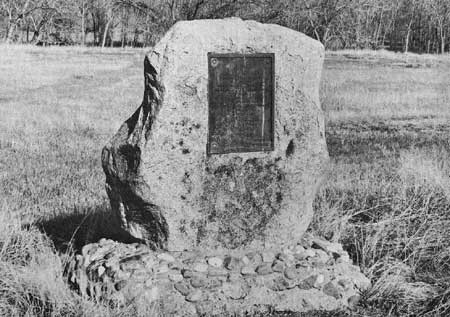|
The Upper Missouri Fur Trade Its Methods of Operation |
 |

1954 view, courtesy National Park Service
By the 1850's the Indians' desires for white man's goods had expanded. Henry A. Boller listed the miscellaneous merchandise at Fort Atkinson, an opposition post near Fort Berthold, in 1858, as follows: blankets, all sizes, all colors, calicos, prints, cotton, ticking, blue and scarlet cloth, lindsay, blue ducking, guns, fuses, revolvers and rifles, prepared bullets (1/2 ounc.) shot and an abundance of powder, together with flints, percussion caps, powder horns, gun worms, awls, beads, all sizes and kinds, hawk bells, gilt buttons, gold and silver lace, sewings, ribbons, fancy caps, combs, "enough to clear out all the heads in the country," butcher knives, files, shears, vermillion, chrome yellow conchonical (used to dye quills for garnishing), brass tacks, Jew harps, brass kettles, camp kettles, tin cups, dippers, copper pots of all sizes, small trunks covered with red morocco and plentifully studded with brass tacks, coffee mills, tin pans, crockery, bowls, mugs and many other articles. "Sugar, coffee and tea are the most profitable articles of trade," he wrote. [22]
The items popular in the Indian trade were obtained from numerous sources. The little bells and mirrors came from Leipzig, the clay pipes from Cologne, beads from Italy, merinos and calicos from France, woolen blankets and guns from England, sugar and coffee from New Orleans, clothing and knives from New York, powder and shot, meat, etc. from St. Louis. At that time the American Fur Company had factories both at home and abroad for the manufacture of its staple goods. Its operations extended from the Upper Mississippi to Mexico. [23]
The extent of the sale of liquor by the American Fur Company and its subsidiaries has long been a subject of controversy. Denig wrote in 1854 that all the Indians "drink whenever they can get it—men, women, and children—except the Crow Indians, who will not taste it." [24] Following the distillery incident at Fort Union in 1833-1834 in which the government learned that the Company had a distillery and was manufacturing liquor in violation of the spirit of the law, the American Fur Company was under considerable criticism for its use of liquor in its trade. The firm's correspondence discloses that its traders did not feel that they could compete with the "opposition," who always seemed to have an ample supply for Indian trade, unless they also used liquor in the business. It appears that at that time liquor was not openly traded within the doors of the company's posts. However, Larpenteur indicates its traders always freely disposed of whiskey outside the walls of the trading establishments. [25] Kurz leads one to believe that while he was at several of the company posts in 1851-1852, the American Fur Company did not trade liquor. He expressed Denig's view that liquor did the Indians no harm whatever and that "they were more reliable, more industrious, and cared more for personal appearance at the time when Uncle Sam allowed them to barter for whisky." The traders' desire for the return of whiskey as an article of trade, Kurz observed, "is the enormous profit they derive from the sale of it—a profit out of all proportion to the one now realized." [26]
The market for products of the fur trade varied considerably fousughout the century. During the first four decades beaver was in great demand. Maximilian estimated in 1833 that the company shipped down the river approximately 25,000 skins. These were shipped in packs of 100 pounds each comprising about 60 large skins in a pack. The usual price was $4.00 per pound. [27]

|

|
|
|
|
Last Modified: Sat, Jan 15 2005 10:00:00 am PDT |


